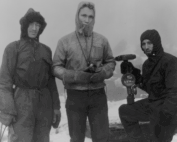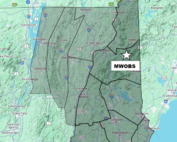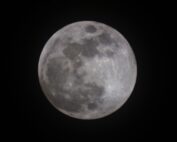A Tribute to Colleagues, Nature, and Research on Mount Washington
By Joshua Elms
Before ever laying eyes upon it, I expected many things from my time at the Observatory. I attempted to imagine exactly what would come of my ambitious research project, how hurricane-force winds would feel tearing at my back, and what it would be like to relax on a couch at the end of a long workday and play video games with my coworkers. Suffice it to say, I got all of the particulars wrong – my research topic shrunk, shifted, and grew over time. Walking in strong winds feels less like a fight against the air than a continual admission of Mother Nature’s dominion. And we didn’t play video games at night, but instead told each other our stories, watched the setting sun, and played either football or “try-to-stay-upright” as the wind permitted. Each of these – colleagues, nature, and research – deserves recognition.
I hope you enjoy reading this as much as I enjoyed writing it and reflecting back on my summer.
Every shift is unique at the Observatory. During the summer, there are two day observers, one night observer, a museum attendant, and two interns, not to mention the two kind souls who volunteer a week of their time to help us cook, clean, and run the museum. Crafting the right combination of eight individuals is one of the chief goals of the hiring process at the Observatory, and I have to imagine that the dynamic present in our shift is precisely what they aspire to. Each of these people has positively impacted my summer in countless ways, and singing their praises exhaustively would require a truly exhausting amount of writing (for me) and reading (for you). Rather, I’ve thought back through my seven shifts on the summit and come up with the one quality of each crew member that I’ll most miss.
Francis – our dedicated Education Observer and the Whisperer of Witticisms. His surgical delivery of soft-spoken one-liner responses to the topic at hand never ceases to crack me up.
Karl – our Research Observer and the Fastest Grin in the West. Like a cowboy drawing on his opposition before they even know they’ve entered a contest, but his weapon of choice is sheer positivity. Karl is often the first to offer a smile and peal of laughter when stories are told, and the atmosphere is that much brighter for it.
Jacob – our other Summer Intern and the Sultan of Selfless Service. Any time there’s an opportunity to help somebody, Jacob jumps at the chance. No honest request goes unheard here at the Observatory, and Jacob has been responsible for a good part of that this summer.
Ryan – our Night Observer, Meteorologist, and Arbiter of Apocryphal Anecdotes. Ryan has two qualities that make him uniquely interesting to talk to: an almost encyclopedic knowledge of the history and functions of the Observatory, and a willingness to share that knowledge. If you hear a summit story of questionable veracity, Ryan can probably tell you whether it’s true. And if it’s not true, he just might tell you an even crazier story that is.
Kelly – our Museum Attendant and the Master of Mail Mysteries. Kelly’s passion for history, especially the local variety, shines through in any conversation longer than “Hello”. Whether she’s making subtle but well-targeted references to the New Hampshire Postal Service or telling you an entire story about it, her expertise and upbeat demeanor were welcome additions this summer.
While the impressive history, location, and technology of the Observatory are all fundamental to its existence, they all exist as a result of its community of passionate employees and volunteers. The staff of the Observatory, including my shift, the other shift, and all of the Valley staff have made this summer one I won’t soon forget. Thanks to them, I’ve had the opportunity to experience what makes the summit of Mount Washington truly unique: its extreme weather.
This has been a summer of shocking highs and lows. One daily station high-temperature record (70 °F on June 19th) surprised me not because of how high it was, but rather how low – that 70 degrees could be anomalously warm anywhere in the continental United States in summer gives me a chuckle to this day. Only nine days later, on June 28th, our shift set an official daily station low-temperature record of 27 °F was by far the coldest day I’ve ever experienced in June. There was more to it than a number on a thermometer, though – the sensation of walking outside and being assaulted by the harsh freezing wind and the ice borne on it was truly alien to me. That alienness was only heightened by the frost-covered tower, the rime ice tendrils stretching into the wind on our yellow-painted stanchions, and the observation that my multi-layered outfit and thick winter jacket were insufficient protection from the elements on this most unusual June 28th.

The wind contorts my fleece into wild shapes while taking wintry pictures.
Our station has been buffeted by winds throughout the summer, with our peak gust of 105 mph having occurred only yesterday (as of this writing). Playing in winds that are normally reserved for hurricanes or the upper atmosphere is a treat that I didn’t properly appreciate until this summer. In most coastal cities on the planet, 80 mph winds are potentially deadly. They can pick up large objects, rip apart dwellings, and cause storm surge and tall waves. On Mount Washington, these same winds are instead a cause for delight. On the observation deck, there is almost no risk of being hit by large flying objects (other than Jacob’s perilously-perched propeller hat); if it can blow off the mountain, it already has.
There was no other option for me: given my fascination with Mount Washington’s extremes, I was sure my research would entail studying the weather. My original research proposal for the summer was tempered in the forge of realistic critique until we reached a workable idea: I would compare the different statistical weather models available at the Observatory. These models use a technique known as Model Output Statistics (MOS) to tailor-fit broader, regional weather forecasts to a single point. MOS was introduced in the early 1970s and has been widely adopted by government agencies, private companies, and hobby forecasters alike for its skill in predicting the weather. The most important thing to understand about the MOS, though, is that it is entirely ungrounded in physics; it might well forecast a relative humidity of 150% even though that value rarely goes above 100% in reality. Instead of simulating physics, the MOS works by learning a statistical relationship between past forecasts and observed conditions and then applying that relationship to future forecasts to predict future conditions.
Three MOS products are most commonly used when producing our 48-Hour Higher Summits Forecast: the GFS MOS, NAM MOS, and National Blend of Models (NBM). The NBM is the newest of the bunch and will be the primary product in a few years when the other two are pulled out of service, but our results show that it tends to struggle in some scenarios. The plot below shows average errors in knots (multiply by ~1.15 to find mph) in the three models’ wind forecasts at different forecast intervals (a.k.a. lead times, or how far in the future the model is forecasting). Lower errors are better, and it’s apparent from these results that the NBM struggles to forecast the winds at the summit. Fortunately, the NBM developers released version 4.2 in mid-May of 2024, which was a targeted update for the wind forecasting algorithm. Once more of these v4.2 forecasts come out, this study can be updated to analyze the improved winds. For now, though, the Observatory will continue to rely on forecaster knowledge and the older MOS products to predict our wind speeds and directions.

The NBM wind forecast errors (MAE) are approximately twice those of the other models.
This research was a great experience that involved many of us here at the summit. First and foremost, Jacob Garside conducted a different half of the study I described above, and his results are equally illuminating. We also received extensive feedback and ideas from Karl, Francis, and the Summit Operations Manager, Jay Broccolo. Without the collaboration of the aforementioned team, this research wouldn’t have happened.
I’m thankful for every facet of the summer. I’ve had the opportunity to meet talented and passionate individuals, experience weather found nowhere else on the planet, and learn more about what makes the Observatory so integral to the community. This summer has not been an easy one. I was challenged every step of the way and gained a deep respect for those who work here longer and in harder conditions than I’ve faced. But the expansion of my worldview has been so drastic that I have to give the following advice: If you ever start to feel like you’ve seen everything the world has to offer, come to Mount Washington. You won’t soon forget it.
A Look at The Big Wind and Measuring Extreme Winds At Mount Washington
A Look at The Big Wind and Measuring Extreme Winds at Mount Washington By Alexis George Ninety-one years ago on April 12th, Mount Washington Observatory recorded a world-record wind speed of 231 mph. While
MWOBS Weather Forecasts Expand Beyond the Higher Summits
MWOBS Weather Forecasts Expand Beyond the Higher Summits By Alex Branton One of the most utilized products provided by Mount Washington Observatory is the Higher Summits Forecast. This 48-hour forecast is written by MWOBS
One Down, One To Go
One Down, One to Go By Ryan Knapp On my calendar for March 2025, I had two reminders of events to look forward to in the sky. The first occurred this past week with




